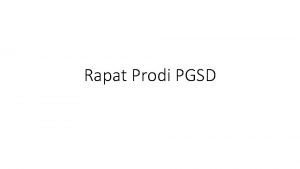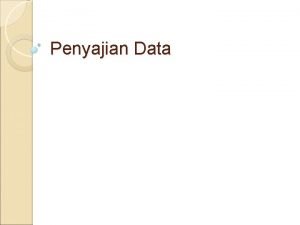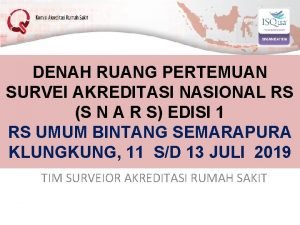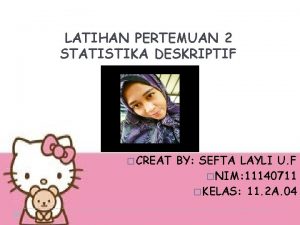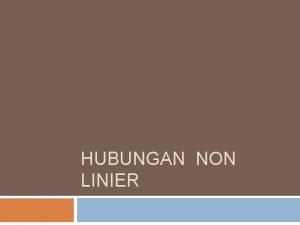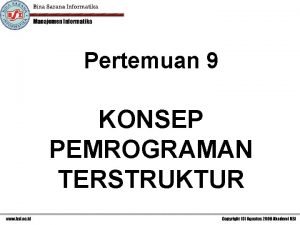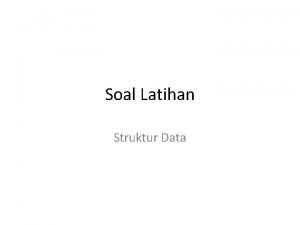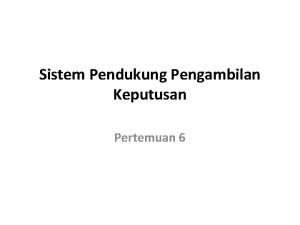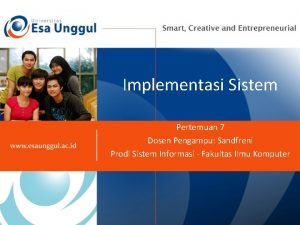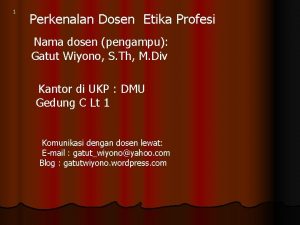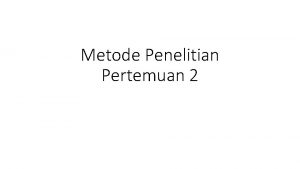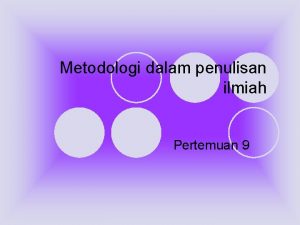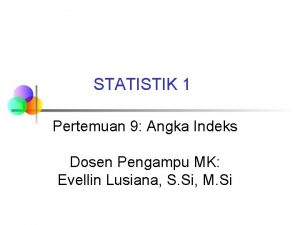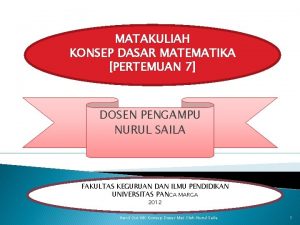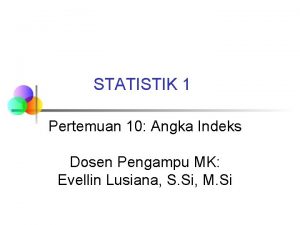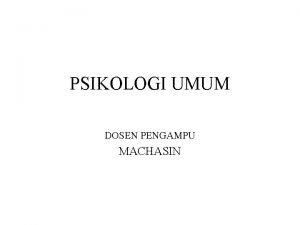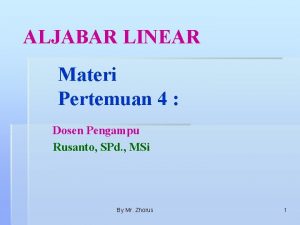Metodologi Test Pertemuan 10 Dosen Pengampu Sandfreni Prodi






![Test cases and Test suites • Test case is a triplet [I, S, O] Test cases and Test suites • Test case is a triplet [I, S, O]](https://slidetodoc.com/presentation_image_h/ae298a1f91180207a153fad9f1a5b719/image-7.jpg)














- Slides: 21

Metodologi Test Pertemuan 10 Dosen Pengampu: Sandfreni Prodi Sistem Informasi - Fakultas Ilmu Komputer

Test methodologies • Functional (Black box) inspects specified behavior • Structural (White box) inspects programmed behavior

Functional Test cases Programmed Specified Test Cases

Structural Test cases Specified Programmed Test Cases

When to use what • Few set of guidelines available • A logical approach could be – Prepare functional test cases as part of specification. However they could be used only after unit and/or system is available. – Preparation of Structural test cases could be part of implementation/code phase. – Unit, Integration and System testing are performed in order.

Unit testing – essence • Applicable to modular design – Unit testing inspects individual modules • Locate error in smaller region – In an integrated system, it may not be easier to determine which module has caused fault – Reduces debugging efforts
![Test cases and Test suites Test case is a triplet I S O Test cases and Test suites • Test case is a triplet [I, S, O]](https://slidetodoc.com/presentation_image_h/ae298a1f91180207a153fad9f1a5b719/image-7.jpg)
Test cases and Test suites • Test case is a triplet [I, S, O] where – I is input data – S is state of system at which data will be input – O is the expected output • Test suite is set of all test cases • Test cases are not randomly selected. Instead even they need to be designed.

Need for designing test cases • Almost every non-trivial system has an extremely large input data domain thereby making exhaustive testing impractical • If randomly selected then test case may loose significance since it may expose an already detected error by some other test case

Design of test cases • Number of test cases do not determine the effectiveness • To detect error in following code if(x>y) max = x; else max = x; • {(x=3, y=2); (x=2, y=3)} will suffice • {(x=3, y=2); (x=4, y=3); (x=5, y = 1)} will falter • Each test case should detect different errors

Black box testing • • • Equivalence class partitioning Boundary value analysis Comparison testing Orthogonal array testing Decision Table based testing – Cause Effect Graph

Equivalence Class Partitioning • Input values to a program are partitioned into equivalence classes. • Partitioning is done such that: – program behaves in similar ways to every input value belonging to an equivalence class.

Why define equivalence classes? • Test the code with just one representative value from each equivalence class: – as good as testing using any other values from the equivalence classes.

Equivalence Class Partitioning • How do you determine the equivalence classes? – examine the input data. – few general guidelines for determining the equivalence classes can be given

Equivalence Class Partitioning • If the input data to the program is specified by a range of values: – e. g. numbers between 1 to 5000. – one valid and two invalid equivalence classes are defined. 1 5000

Equivalence Class Partitioning • If input is an enumerated set of values: – e. g. {a, b, c} – one equivalence class for valid input values – another equivalence class for invalid input values should be defined.

Example • A program reads an input value in the range of 1 and 5000: – computes the square root of the input number SQRT

Example (cont. ) • There are three equivalence classes: – the set of negative integers, – set of integers in the range of 1 and 5000, – integers larger than 5000. 1 5000

Example (cont. ) • The test suite must include: – representatives from each of the three equivalence classes: – a possible test suite can be: {-5, 500, 6000}. 1 5000

Boundary Value Analysis • Some typical programming errors occur: – at boundaries of equivalence classes – might be purely due to psychological factors. • Programmers often fail to see: – special processing required at the boundaries of equivalence classes.

Boundary Value Analysis • Programmers may improperly use < instead of <= • Boundary value analysis: – select test cases at the boundaries of different equivalence classes. – test cases must include the values: {0, 1, 5000, 5001}.

Example • For a function that computes the square root of an integer in the range of 1 and 5000: – not serviceable, go to shutdown mode; else – if the steaming rate measurement device is not serviceable, go to shutdown mode; else – if less than three feedpump/feedpump monitor combinations are working correctly, 5000 go to 1 shutdown mode; else. . . • modified
 Mahasiswa takut pada dosen
Mahasiswa takut pada dosen Pengampu
Pengampu Pangampu
Pangampu Kkni level 8
Kkni level 8 Sp. kklp
Sp. kklp Program kerja prodi pgsd
Program kerja prodi pgsd Akreditasi prodi di ipb
Akreditasi prodi di ipb Peran sosiologi dan antropologi dalam bidang gizi
Peran sosiologi dan antropologi dalam bidang gizi Tugas pertemuan 9 metode perancangan program
Tugas pertemuan 9 metode perancangan program Apakah pengertian diagram batang
Apakah pengertian diagram batang Pendekatan aditif adalah
Pendekatan aditif adalah Pertemuan multikultural
Pertemuan multikultural Denah ruang pertemuan
Denah ruang pertemuan Contoh hiperkorek pleonasme dan kontaminasi
Contoh hiperkorek pleonasme dan kontaminasi Creat by
Creat by Pada pertemuan kali ini kita
Pada pertemuan kali ini kita Pertemuan ini
Pertemuan ini Pertemuan 9
Pertemuan 9 Pertemuan awal pkh adalah
Pertemuan awal pkh adalah Dari gambar ini notasi infix yang dihasilkan adalah :
Dari gambar ini notasi infix yang dihasilkan adalah : Spk latihan pertemuan 6
Spk latihan pertemuan 6 Sel adalah pertemuan antara titik-titik dan titik-titik
Sel adalah pertemuan antara titik-titik dan titik-titik





